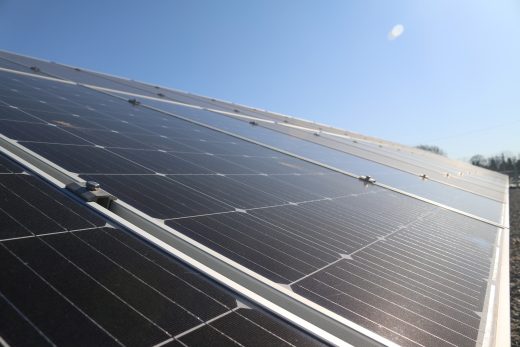Leveraging Oregon’s generous solar incentives for sustainable architecture design, Photovoltaics save money and energy, Building PV electricity
Leveraging Oregon’s Generous Solar Incentives for Sustainable Architecture Design
13 November 2023
Have you noticed solar panels popping up across Oregon lately? With the state’s renewable energy goals and rising costs, now is the time to take advantage of generous solar incentives.
This article explores using solar power to design sustainable buildings in Oregon. You’ll learn how net metering, tax credits, rebates, and streamlined permitting make solar financially smart. With good design and energy modeling, solar can significantly lower costs and environmental impact. Case studies show solar architecture thriving statewide.
Oregon has opened the floodgates for solar by making it so lucrative. Architects and contractors with solar expertise have a competitive edge and can create value for clients. The benefits are too good to ignore. Let’s dive in and see how Oregon is leading the way in empowering sustainable architecture with solar incentives!
Solar Energy’s Vital Role in Sustainable Architecture
Sustainable architecture design ideas aim to reduce environmental harm from the built environment. Some key goals are enhancing energy efficiency, using eco-friendly materials, and minimizing greenhouse gas emissions. This is where solar energy shines.
Solar PV systems directly convert sunlight into electricity using semiconductors. The modular panels can scale to any building size and avoid fossil fuel consumption. Solar PV combined with battery storage provides resilient clean power without relying on the grid.
Passive solar building design also harnesses the sun’s energy through strategic orientation, shading, and daylighting. And solar thermal systems use solar heat for water heating and space heating.
Solar panels were once bulky black rectangles, but building-integrated photovoltaics (BIPV) seamlessly embed solar cells into roof tiles, windows, skylights, shading, and facades. BIPV replaces exterior materials with energy-generating ones.
For example, the Opticos headquarters in Berkeley has vertical cedar slats on the facade that double as solar panels. And The Solaire in New York City integrates ultra-thin solar laminates into the glass curtain wall.
Solar energy allows buildings to become self-sufficient mini power plants. The environmental benefits combined with financial incentives make solar a lucrative investment in sustainable architecture.
Oregon’s Supportive Policies for Solar Energy Adoption
Oregon has pioneered policies to meet its goal of 50% renewable electricity by 2040. This strong support makes solar adoption really attractive.
The state requires net metering so excess solar energy fed into the grid offsets your charges. Although credits don’t roll over yearly, net metering slashes utility bills for solar owners.
Oregon residential solar incentives go up to $6,000 for new systems, plus up to $1,500 more for adding battery storage. Commercial projects get solar tax credits up to $20 million – a huge reduction in payback time.
There’s also a property tax exemption on the value solar adds to your home. Some cities like Portland and Eugene even exempt commercial solar from property tax.
On top of that, Energy Trust of Oregon provides cash rebates up to $5,000 for homes and $500,000 for businesses. These upfront incentives lower equipment costs.
Oregon passed solar access laws to prevent shading from new construction too. And the state has above-average sunlight to make panels more productive.
With this robust support for renewables, Oregon makes going solar really easy and cost-effective.
Financial Incentives for Incorporating Solar in Building Design
At the federal level, solar projects are eligible for a 26% investment tax credit (ITC) until 2032. Most commercial installations can qualify.
Residential solar also gets a 26% federal tax credit until 2034. There is no maximum limit on the credit amount.
Oregon has an additional residential solar tax credit equal to $0.60 per Watt up to $6,000. This “kicker credit” is stackable on top of the federal ITC.
There is also a state tax credit of up to 50% of equipment costs for commercial solar projects, capped at $20 million. The actual percentage depends on the amount of local materials and labor used.
Solar renewable energy certificates (SRECs) provide another revenue stream. Each 1 MWh of solar generation earns 1 SREC, which can be sold to utilities to meet renewable portfolio standards.
In Oregon, SRECs currently trade around $100/MWh. Over time, SREC income can provide substantial value.
On top of tax credits, Energy Trust of Oregon offers cash incentives up to $5,000 for home solar and up to $500,000 for commercials. These rebates offset upfront costs.
Between state tax credits, federal ITC, SRECs, and Energy Trust incentives, Oregon solar projects can achieve payback in 5-7 years.
Key Considerations for Architectural Integration
To maximize solar production, building orientation and shading are crucial. South-facing roofs with limited shading are ideal for PV. For passive solar design, orient windows toward the equator.
Electrical loads like HVAC should run during solar peak output. East-west building dimensions allow daylight penetration, reducing lighting demand. Horizontal shading blocks high summer sun angles while allowing lower winter sun.
Solar PV can be a stylistic statement. Many clients want the symbolism of visibly “green” buildings. Solar roof tiles, solar windows, and building-integrated PV create dynamic facades showcasing sustainability commitments.
However, solar equipment adds weight. Roof structures may need reinforcement, and wind uplift calculations are essential. Seismic analysis is critical in Oregon.
Accurate energy modeling informs solar system sizing. Undersized systems will not fully offset electricity usage. Oversized systems incur unnecessary expense and clip output. Architect-led energy modeling optimizes solar.
Navigating the Incentives and Rebates Application Process
Navigating solar incentives can feel overwhelming with so many options from different groups. But staying organized and planning ahead makes the process smoother and gets you the most value in Oregon.
- First, focus on incentives that fit your specific solar installation. Review the requirements upfront so you don’t waste time on ones that don’t apply.
- Pay attention to deadlines for each program and get applications in on time. Some have short windows, so map those out early.
- Put together the needed documents ahead of submissions – W-9 forms, diagrams, spec sheets, permit copies, commissioning data. Use a spreadsheet to track details for each incentive.
- Consider hiring a solar consultant who knows the ins and outs of securing incentives. Their expertise prevents leaving money on the table.
- For tax credits, have an accountant file the right IRS forms to claim the federal ITC and Oregon credits.
- Apply for Energy Trust cash incentives that lower upfront costs. Submit commissioning data once the system is operating.
- Register with WREGIS to qualify your solar for SREC income.
- Contact your utility about net metering and interconnection to get bill credits.
- You may get more selling excess SRECs to aggregators rather than the utility.
- Check on local property tax exemptions if relevant.
- Reinvest incentive dollars into more sustainability – EV stations, geothermal HVAC, building automation.
With some dedication, you can make the incentive process smooth and rewarding. Put as much effort into capturing incentives as you do into system design and installation. The benefits make it very worthwhile.
Case Studies of Impactful Solar Architecture Projects in Oregon
The Orchards at Orenco
This mixed-use apartment complex in Hillsboro has over 350 kW of rooftop solar across 14 buildings. The PV installation was incorporated early in design and supplies 20-25% of the project’s electricity. The solar panels have enhanced branding and earned LEED Gold certification.
Portland Community College Newberg Center
PCC’s Newberg campus included a 715 kW rooftop solar system covering almost every viable roof surface, complemented by a large solar-ready parking canopy. The combined PV systems generate over 1 million kWh annually, offsetting 53% of campus electricity usage.
OHSU Center for Health & Healing Building
Oregon’s largest hospital features a 530 kW rooftop solar array covering over 53,000 square feet of roof space. The PV system supplies 9% of the building’s annual electricity and broadcasts real-time energy generation data for display in the lobby.
Net Zero Oregon Military Museum
Located at the Oregon National Guard’s Camp Withycombe, this net zero energy building has a 86 kW rooftop solar PV system coupled with passive solar design. The project exemplifies sustainability for the National Guard while honoring veterans.
Future Outlook for Solar Growth in Oregon’s Architecture Domain
Solar energy is poised for continued growth in Oregon’s architecture domain. The state recently implemented a commercial “solar-ready” building code that requires new constructions to have ample south-facing roof space and electrical infrastructure to easily add solar PV systems later. As existing buildings get refurbished down the line, solar capability will be baked into the upgrades.
Emerging solar technologies like organic photovoltaic cells, solar paints, and windows with embedded solar cells will also give architects unprecedented freedom for seamless integration. And solar costs continue to fall as efficiency rises, improving return on investment.
Coupled with Oregon’s strong financial incentives and increasing utility rates, the economics clearly support installing solar panels on both new and old structures alike. Solar energy helps future-proof building projects by providing insulation against rising electricity bills and power outages.
Architects skilled in solar design best practices and thoughtful integration techniques will have a competitive advantage in the market. Construction firms can also establish solar divisions to broaden revenue streams. With clear business cases and supportive state policies, solar energy’s success in Oregon is attainable.
Generous solar incentives for sustainable architecture Final Thoughts
Oregon offers generous solar incentives that provide an ideal opportunity to incorporate solar power into sustainable architecture. Lucrative tax credits, cash rebates, and supportive policies create substantial financial benefits for solar projects in the state. Strategic building orientation and thoughtful integration methods allow solar panels to enhance a structure’s aesthetics.
In addition, utility bill savings give clients lasting value for years after installation. Architects and builders with expertise in utilizing Oregon’s solar incentives have a competitive edge in the market. The state’s favorable solar economics make now an opportune moment to capitalize on renewable energy and build a more sustainable future.
Comments on this guide to Leveraging Oregon’s Generous Solar Incentives for Sustainable Architecture Design article are welcome.
Solar Panels Articles
Solar Panels Posts
How architects implement solar panels in design

image source : pixabay.com
DIY Solar System: how to install solar panels
Before Installing Solar Panels
Types of roofing for solar panel installation
Installing Solar Roof Ventilation in Your Home
Building
Residential Architecture Articles
Comments / photos for the Leveraging Oregon’s Generous Solar Incentives for Sustainable Architecture Design page welcome



